AC Milan ended the week on a high with three league points and a 3-0 win over Monza at San Siro, following up their victory against Newcastle United in the best way.
The Rossoneri raced into the lead in the third minute following Tijjani Reijnders’ mazy dribble and toe-poke finish. The home side controlled the visitors, with and without the ball, for the majority of the first-half and capped their dominant display by making it 2-0 just before half-time.
The second goal came from the second phase of a corner kick, when Rafael Leão’s low cross into the six-yard box was met by Jan-Carlo Simic’s determined slide – making it a “dream” debut for the 18-year old substitute.
After the break, Milan initially switched to a more passive approach out of possession which afforded the visitors more of the ball. This new priority of maintaining a compact defensive shape did limit the away side’s joy in the final third. The hosts also had Mike Maignan to thank for keeping the scoreline at 2-0 in the 61st minute after Andrea Colpani’s close-range shot.
Milan put the victory beyond any doubt in the 76th when Noah Okafor put the finishing touch on a slick attack. Ismaël Bennacer found Reijnders between the lines, allowing the Dutch midfielder to carry the ball into the final third before picking out Giroud inside the box. The French striker showed equally impressive awareness and deftness of touch to cushion the ball into the path of the Swiss substitute to steer home into the bottom corner.
Here to pick out some tactical observations from the comfortable win is @Tactics_Tweets.
Set-ups and gameplans
Stefano Pioli made two personnel changes to the starting eleven that beat Newcastle United in midweek, with Simon Kjær and Tommaso Pobega replacing Davide Calabria and Yunus Musah.
Systematically, Milan switched to a back three, both in attacking and defensive phases. Pobega started the game as the outside left centre-back, alongside Kjær in the middle and Fikayo Tomori as the outside right centre-back. The home team aimed to form a 3-2-5 structure in possession, and started with Alessandro Florenzi moving inside to play alongside Reijnders but changed midway through the opening forty-five minutes due to Pobega’s injury.
From this point, Florenzi operated more as a right wing-back (presumably to help protect the side which Simic was defending), and therefore Ruben Loftus-Cheek was tasked with dropping deeper to join his Dutch teammate in central midfield. Whilst Milan maintained this overall shape throughout the game, the individual components varied as a result of tactical adjustments, injuries and substitutions.
In defensive phases, Milan used different approaches in either half. In the first, Milan were proactive without the ball, pressing player-for-player and high up the pitch, before dropping into a more zonally focussed 5-4-1 low block. In the second period, Milan predominantly sat in their default mid-to-low blocks to protect their half and penalty area.
For Monza, Raffaele Palladino made two changes to the team which started their last fixture. Luca Caldirola came into the heart of the back three and last week’s super sub Dany Mota, earned himself a starting berth in attack. The away team operated in a 5-2-3 in defensive phases which switched into a 3-4-3 / 3-2-5 when attacking.
Mirroring Monza
Pioli discussed his decision to switch to a back-three system post-match, explaining: “The tactical choice is because we want to be aggressive, we accept numerical parity up front and at the back.”
He added: “…they attack with five men and therefore we defended with five men so as not to let the full-backs run too much.”
But Pioli’s explanation only highlighted some of the reasons for mirroring Monza’s shape. As the following examples will demonstrate, other upsides Milan’s tactical tweak afforded them were ball retention, creating 1v1 attacking situations and aiding their high press.
In the 2nd minute, Milan had their first spell of settled possession and their possession structure became visible. Below you can see the back three spread across the pitch to make it difficult for Monza’s first line of defence (three forwards) to press.
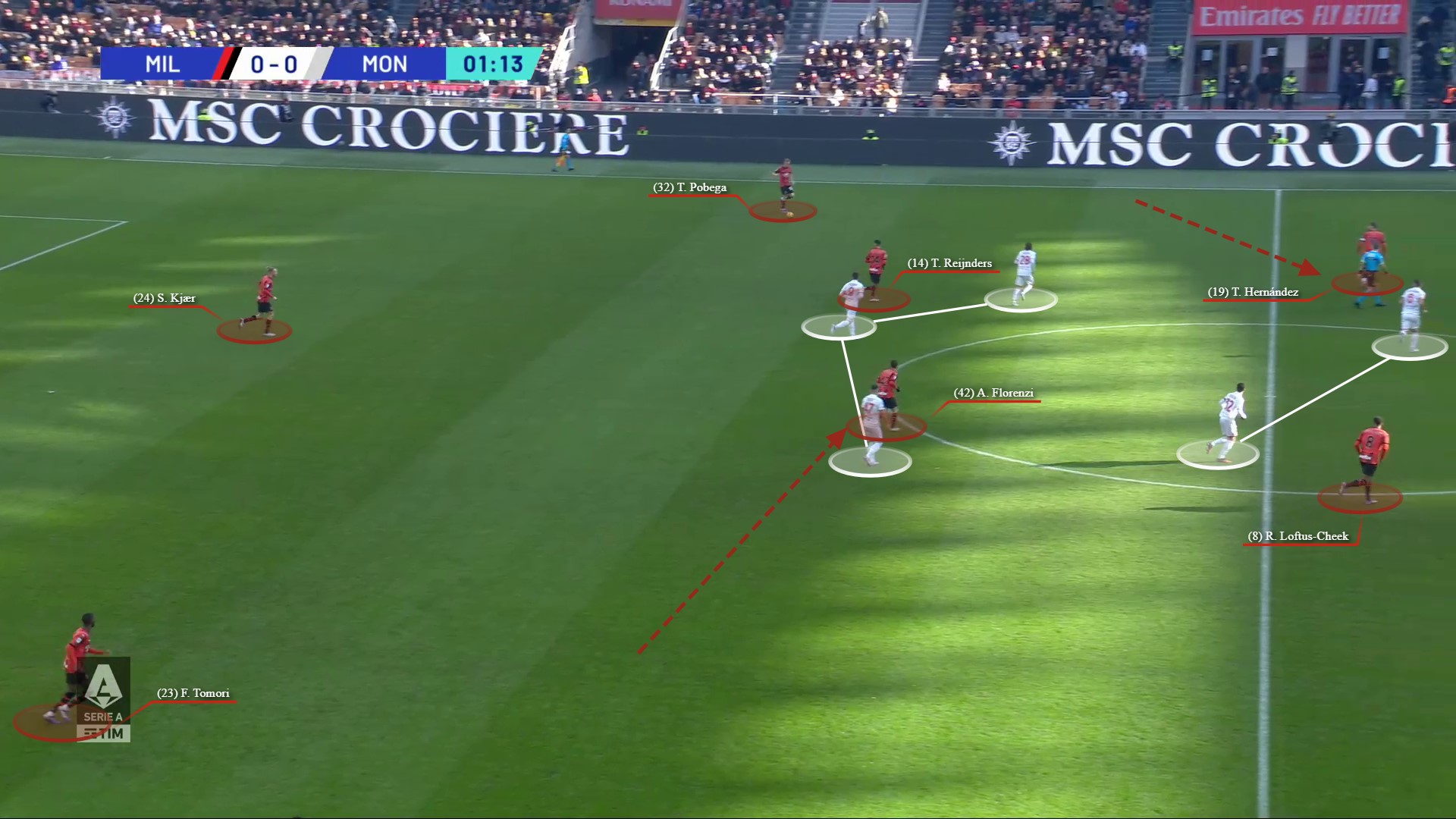
As Monza wanted to protect central areas of the pitch, Milan’s outside centre-backs had the benefit of time and space on the ball, which enabled Milan comfortable possession and the ability to build their attacks – contributing to their 55% possession in the first-half.
In the image above you can also see Florenzi pushing infield alongside Reijnders, and more importantly inside the Monza defensive block. This inversion from the Milan right-back helped further narrow the top-end of the opposition block as they did not want to allow passes into this area, especially with two players to contend with.
Finally, in the previous image, note Theo Hernández operating as left-sided midfield 8. The French full-back interchanged positions with Rafael Leão (one wide and one inside) on the Milan left-side to occupy and disjoint the right-side of the Monza defensive block.
Whilst the above possession sequence nearly led to a Loftus-Cheek 1v1 opportunity with the Monza goalkeeper, the home fans did not have to wait too much longer for their team’s actual first attempt on goal.
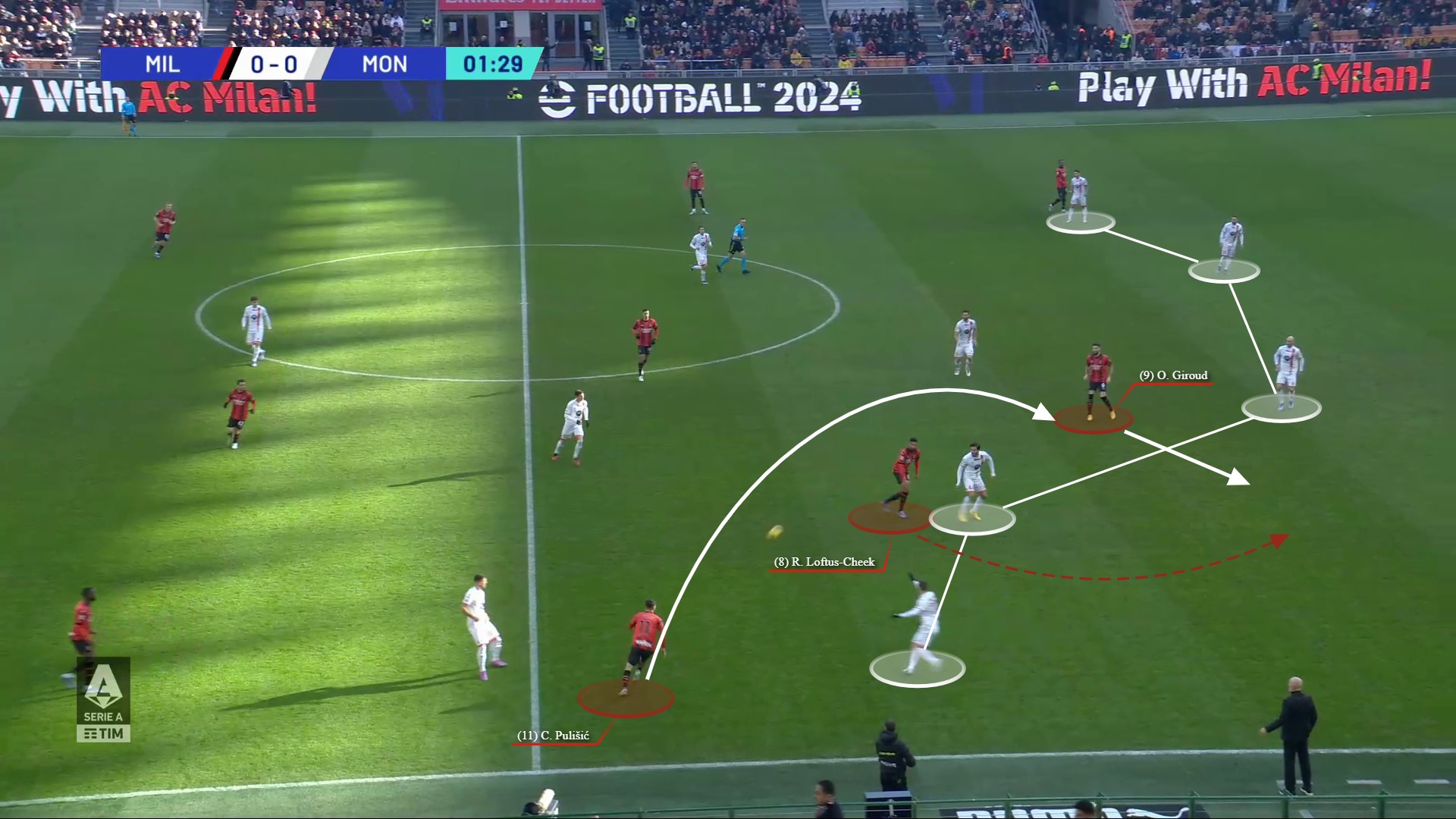
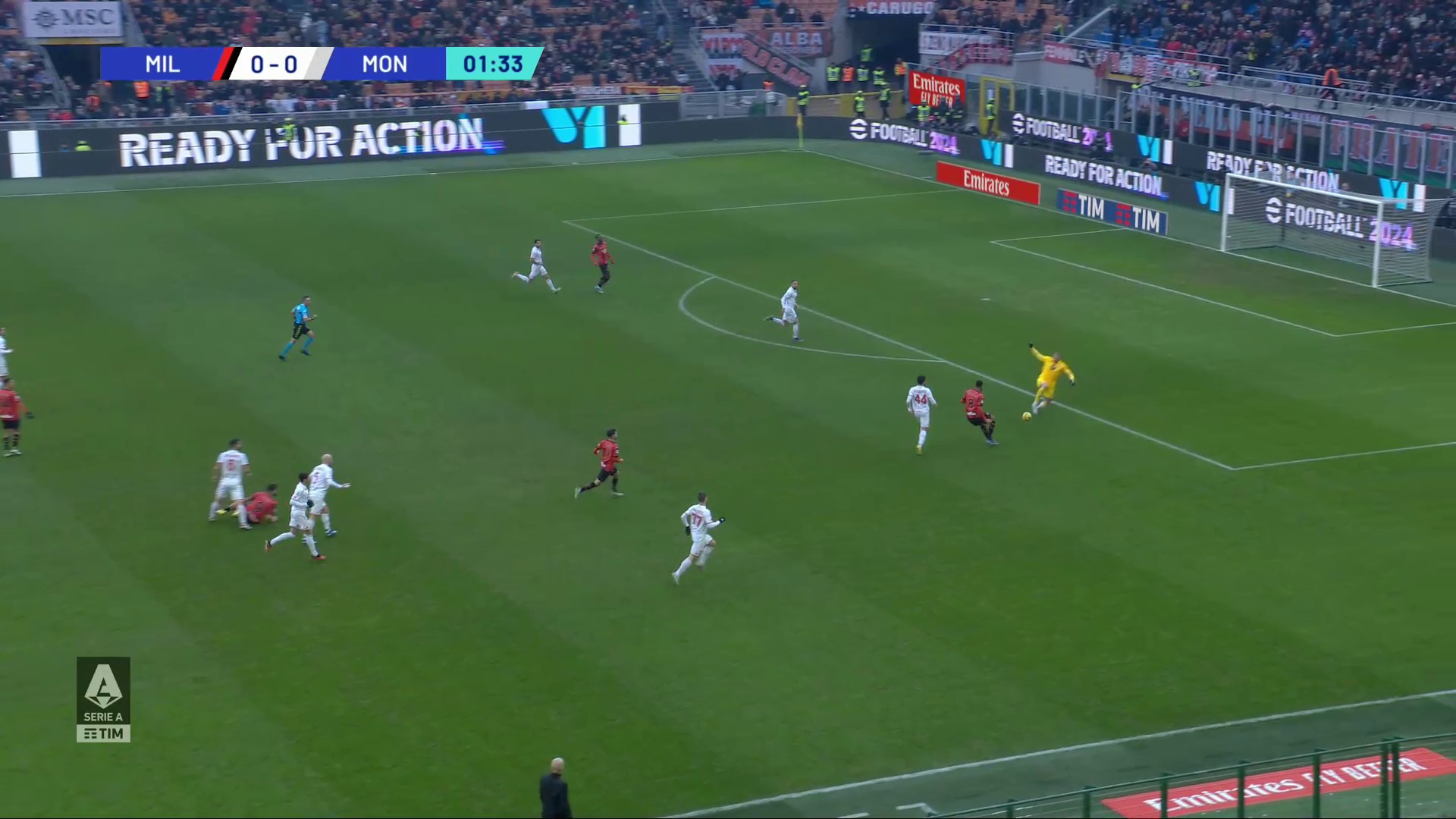
The hosts’ high pressure shortly following the above action helped force two Monza clearances, the second of which led to a Milan regain. Play was worked over to their right flank where Pulisic was 1v1 against the opposition defender. The American attacker beat his man before crossing for Giroud to narrowly head over the bar.
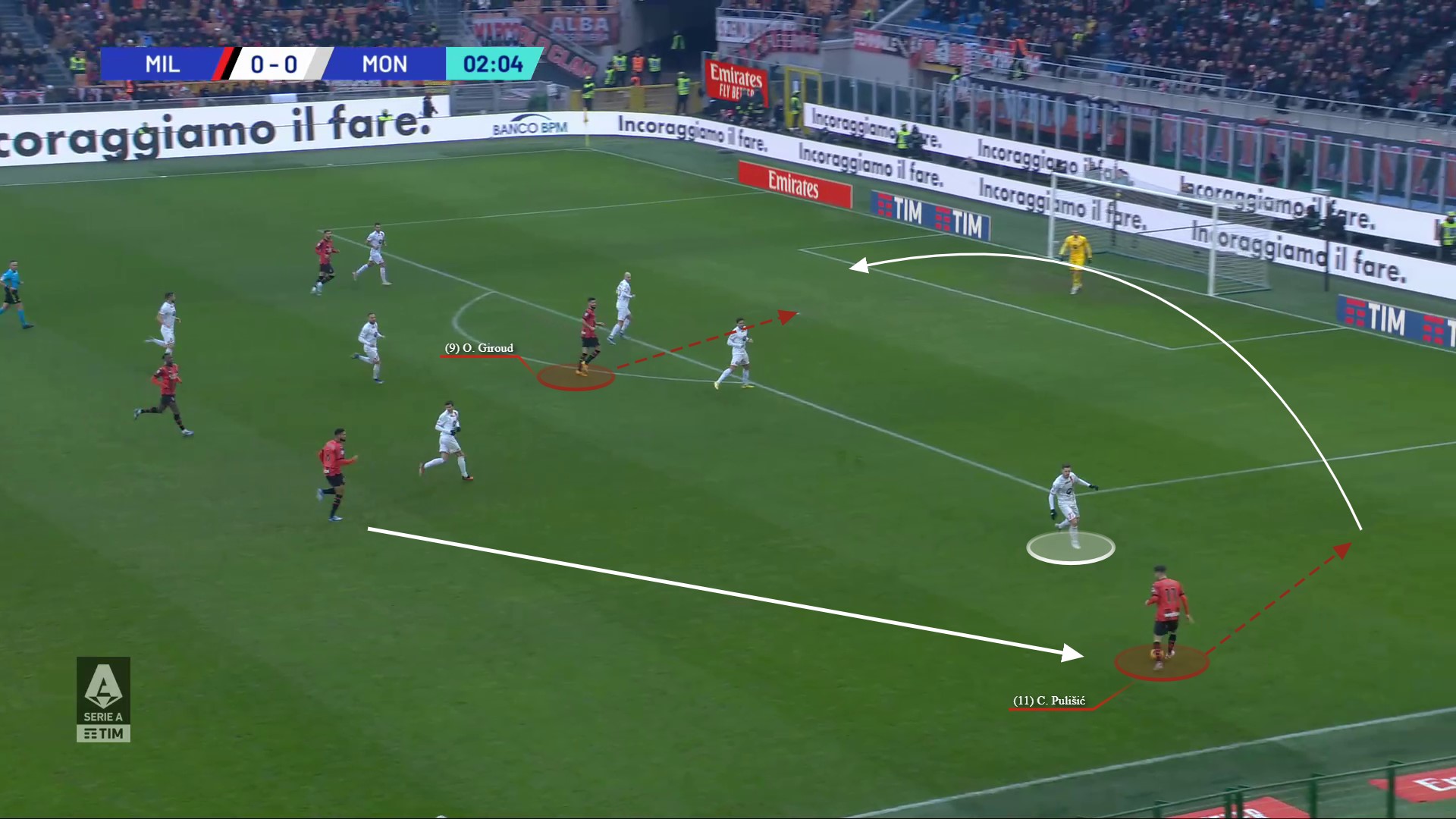
From the resulting Monza goal kick that followed Giroud’s headed shot, Milan went 1-0 up. The home team’s high block forced a turnover, Reijnders received the ball, and the Dutch midfielder waltzed through the opposition defence before striking through Michele Di Gregorio’s legs.

Milan’s attacking structure and off-ball intensity had not only helped contribute to their early threat but also their opening goal. See above how the Monza defenders initially focussing on their 1v1 match-ups played a (small) part in creating Reijnders’ path directly towards goal.
Milan’s high press continued to prove effective for the remainder of the game, forcing seven high turnovers in total, two of which led to shots (source: markstats). The general benefit, however, was disrupting Monza’s build-up play.

Here’s an example of Milan’s high press in practice from the 7th minute where Monza attempted to play out via their left-hand side. Each of Milan’s three forwards had a designated opponent in the opposition back three. Reijnders was pushing up to his man in the double pivot and Florenzi was primed to get out to the left wing-back should he receive the ball, which he did.
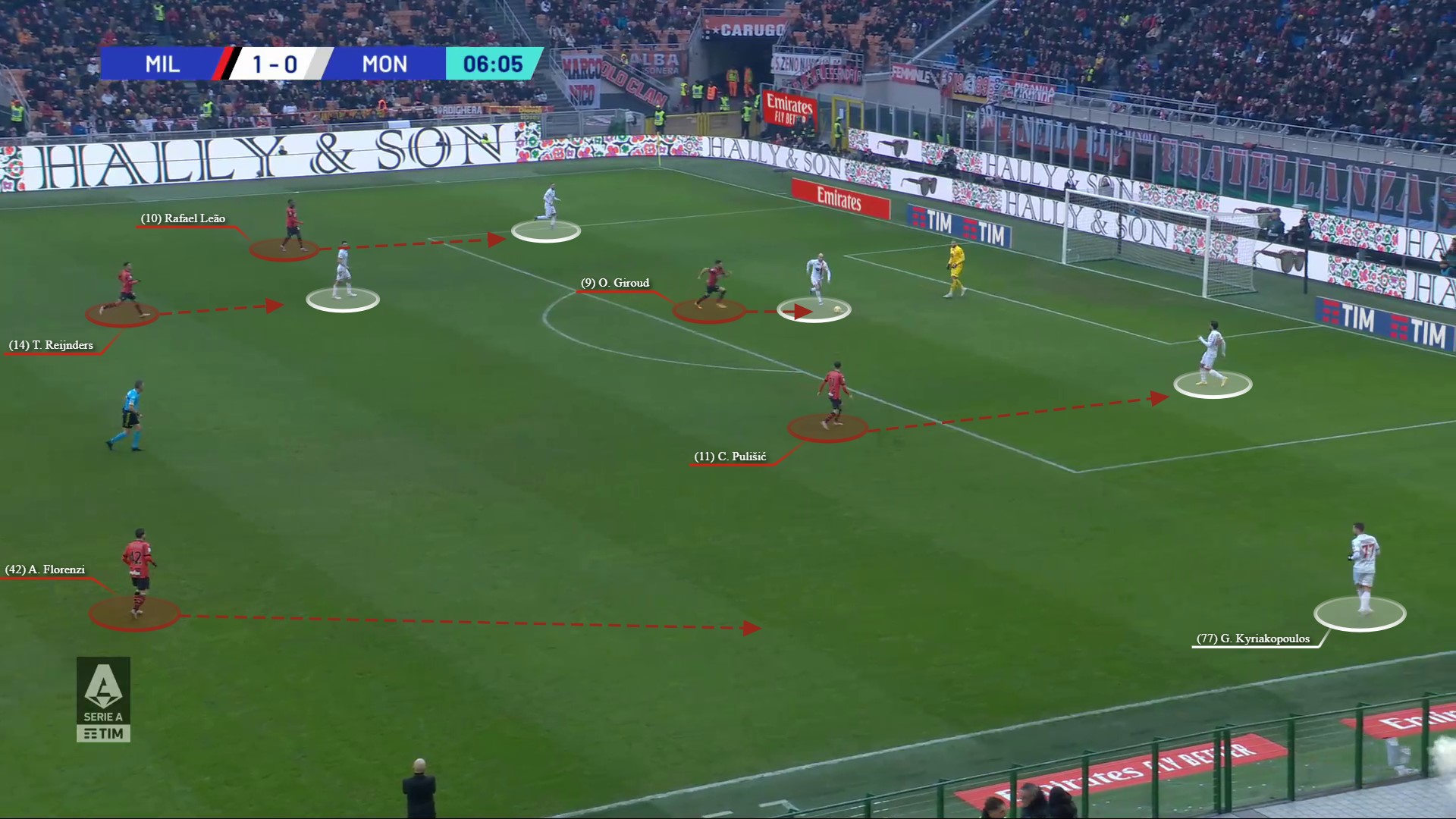
As a result, Florenzi jumped to engage, but he was not the only one. A pass down the line to the dropping left-sided Monza attacker also caused Tomori to jump high to press. Milan’s collective pressure forced the away side back towards their own byline that concluded in one of their high turnovers.
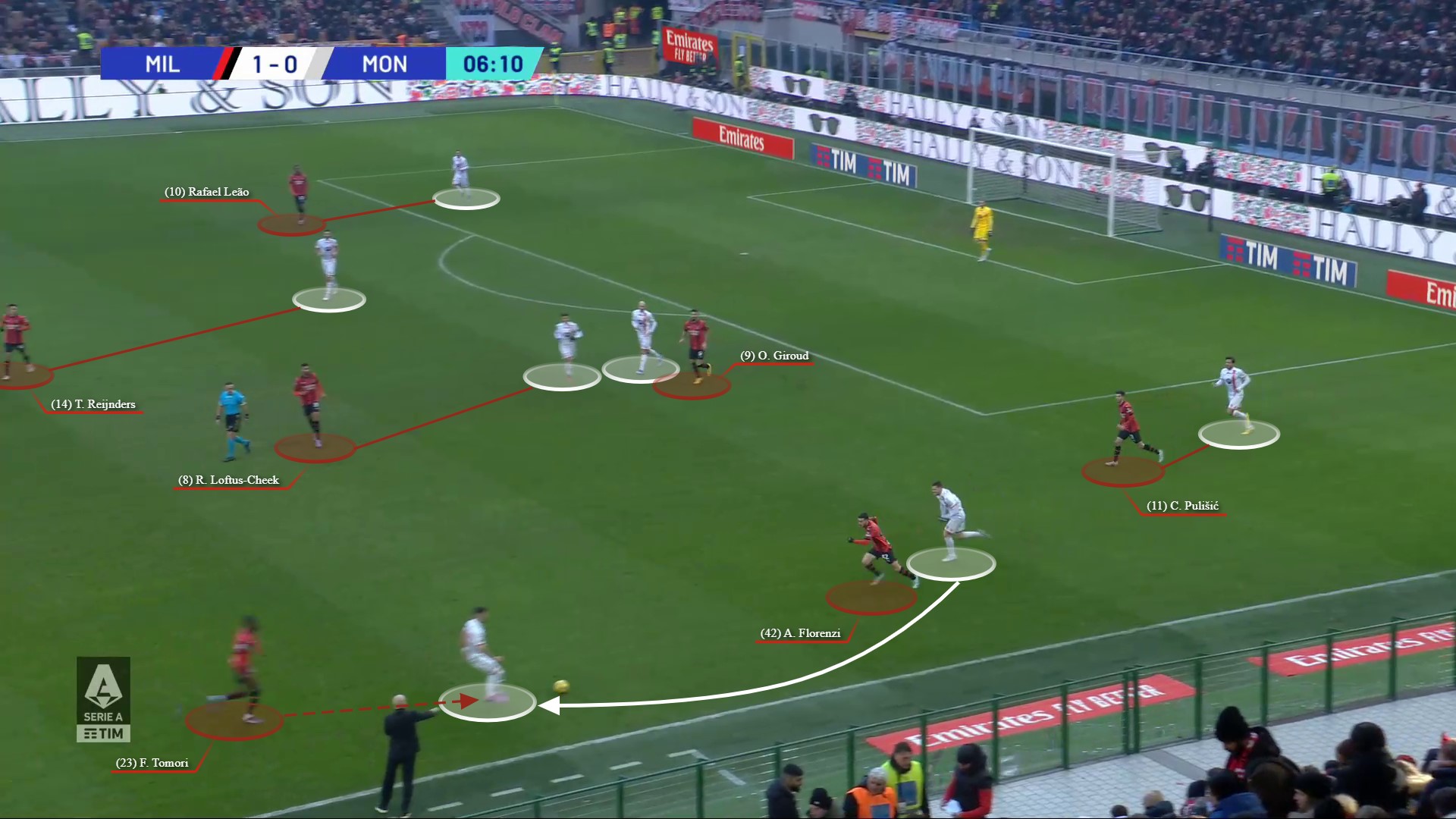

In the 24th minute, Pobega had to be replaced due to injury, granting the debut opportunity for Simic. Milan opted to make some positional adjustments from this point, although their attacking and defensive structures remained the same and their system continued to find upsides against Monza.
As per this example in the 39th minute, where you can see the new back three arrangement of Simic on the right and Tomori on the left. Both outside centre-backs still split across the pitch, allowing Tomori time and space to receive the pass from Kjær. Also note below, Florenzi now wide right and, in this instance, Hernández provided the width on the left with Leão inside.

Tomori’s wider positioning helped enable his progressive pass into Leão who immediately flicked the ball into Giroud for a one-two.

Leão then carried diagonally towards the now disjointed Monza backline. Pulisic, initially positioned in the right half-space made a diagonal run which helped create both a central passing option for himself but also more space on the right for Florenzi to arrive into.
The latter was the chosen pass and Florenzi shot across goal forcing a good save from Di Gregorio whose strong hand diverted the ball behind.

In a similar turn of events to the first, from this resulting corner kick Milan doubled their lead. The home team had attempted a set-piece routine which didn’t come off but it did allow Milan to retain possession creating the opportunity to capitalise from a second phase attack which Simic will never forget by smashing the ball into the roof of the net to send his side in, two goals ahead.
On the flipside of these aforementioned upsides, Milan’s tweaked system also had its own inevitable downsides. The biggest potential risk was their player-orientated high press leaving their backline not only disjointed but also in 1v1 match-ups.
Fortunately for Milan, however, Monza were unable to frequently expose nor take advantage of this weakness. The away side’s best opportunity in the first-half did come from this exact type of attack though. After bypassing Milan’s pressure in their own half, Monza progressed into Milan territory with a 4v4 opportunity ahead.
The Milan collective of four initially appeared to limit the Monza attacking moment to a shot from outside the area but a ricochet landed at the feet of Lorenzo Colombos inside the box. The Milan loanee looked to have a golden opportunity to level but for a last-ditch block from Kjær.
In the second half, the Milan collective – with the help of individuals – continued to protect their lead, but now using a slightly different approach.
Managing the game
After the interval, Milan started the half more passively out of possession. The home team opted to sit in a 5-2-3 mid-block which dropped into a 5-4-1 low block as Monza approached the opposition penalty area.

Milan’s lower engagement without the ball, and the game state, afforded Monza a higher share of possession in the second half (66%) compared to the first (45%). The home team did pick up their off-ball intensity towards the end of the game, helped by a number of fresh legs coming onto the field.

However, whatever defensive tactics Milan did employ, Monza could not find a way through to penetrate. The away side did manage to generate 22 shots on goal, according to Wyscout, but it was very much a case of quantity of quality. As highlighted, on the two occasions when the Milan collective appeared to have been beaten, individuals (first Kjær and then Maignan) stepped up to prevent any goals from being conceded.

Milan’s game management after the half-time break also extended to their substitutions, with the likes of Bennacer helping regain control in possession and Okafor providing energy in transition and off-ball pressure.
Both of these players were also involved in Milan’s third goal which helped wrap up the win.
Next up
Despite his team’s convincing victory, Pioli was quick to remind everyone post-match that: “We must continue like this.”
He reiterated the club’s: “goal is to get into the top four and we have to keep winning games.”
Up next for Milan, bottom of the league Salernitana on Friday evening, where another win and performance will be expected.

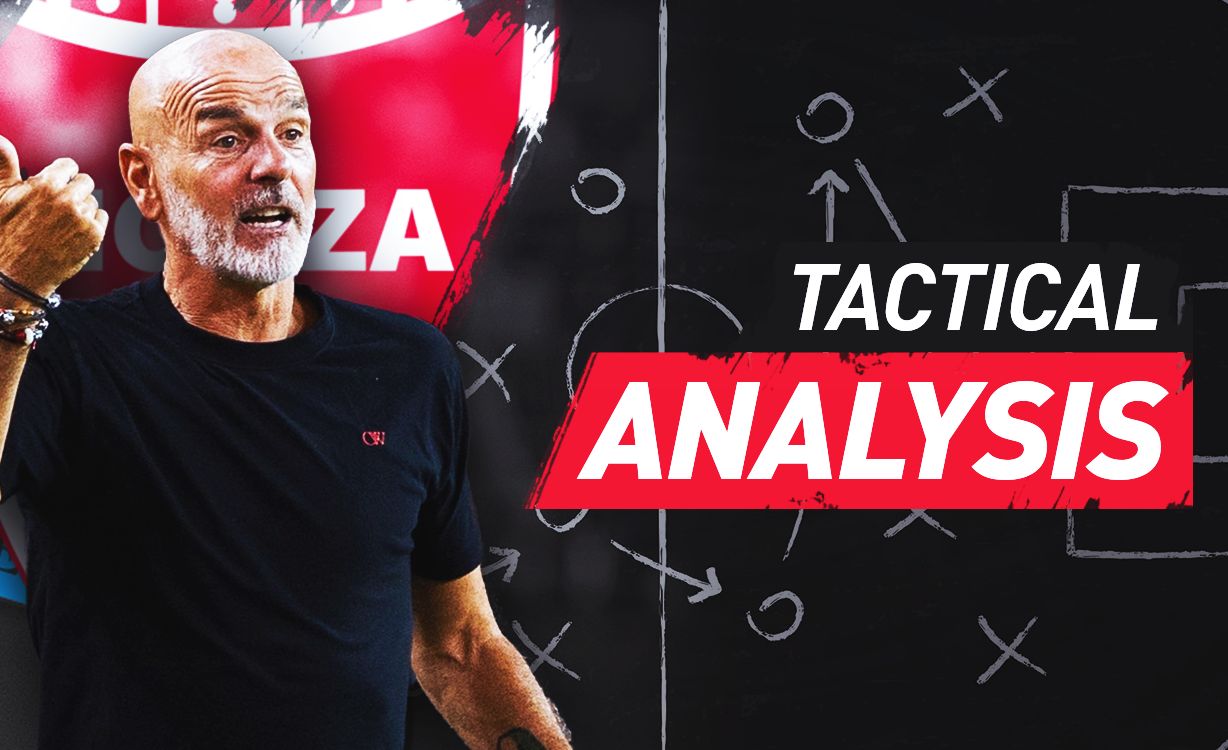
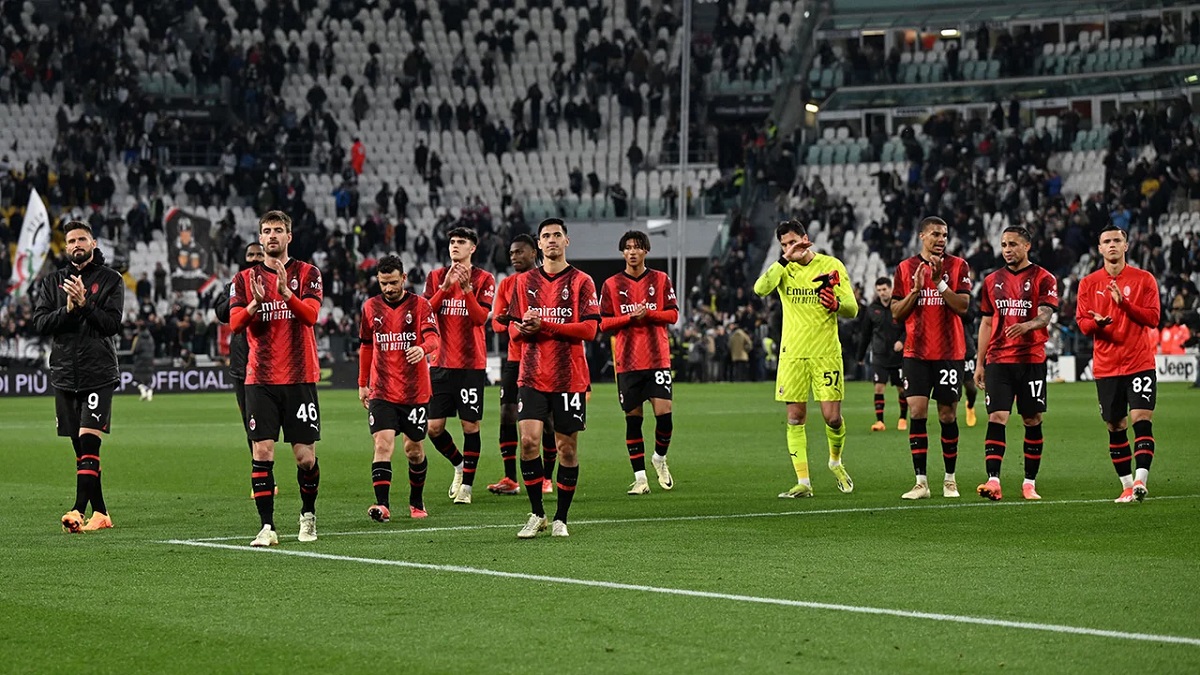

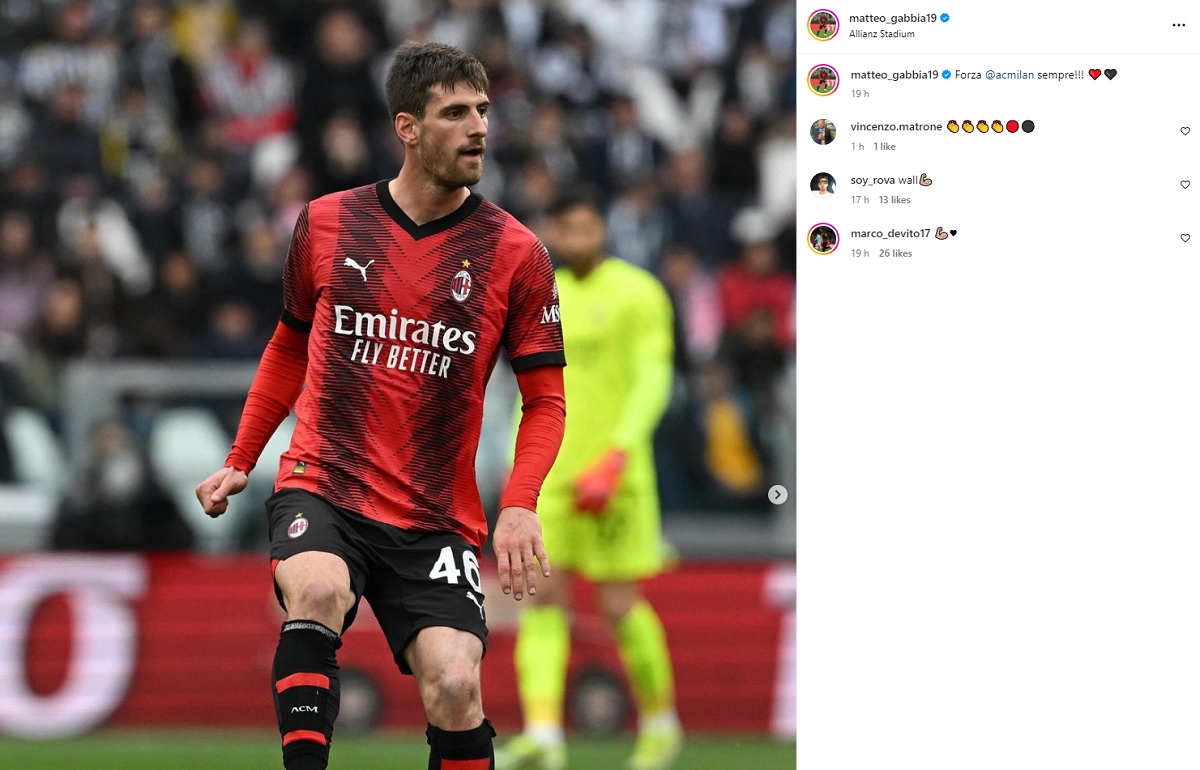
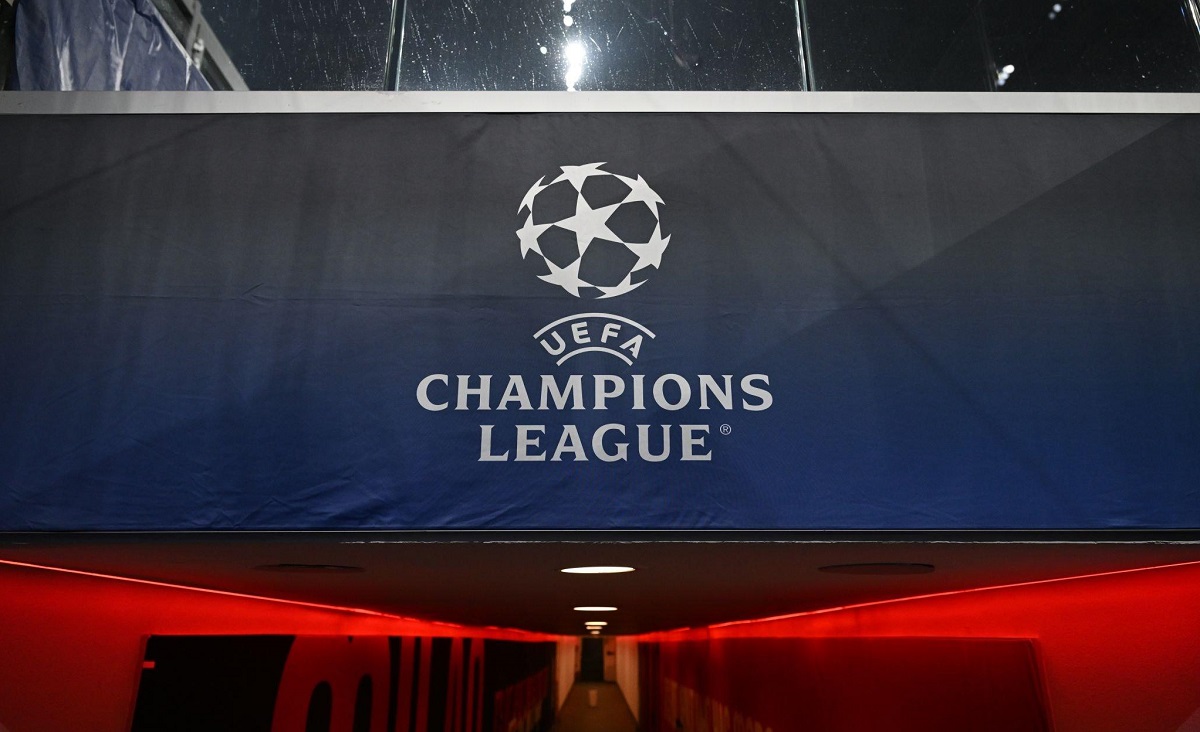

I would prefer to see intelligent comments under articles like this. Maybe even some criticism. But no…it’s not a article about how Milan are linked with a $40m striker that will come and magically solve all their problems.
It is why we get 90% ignorant comments from slow thinking people on post here.
Insulting people you don’t know physically just because you are not getting the mental fix you want from them.
Tsk tsk. That’s not a good start, or anyway to get what you want, but you do you.
Oh that wasn’t me requesting they change their ways. Train has passed on that.
That was me judging them. After eons of observing.
Fair enough.
I thought that Milan looked good going forward, but the defense still has problems and you can see the silly amount of xG allowed to Monza — Milan had a little luck and some good goalkeeping. They actually allowed MORE xG after the change to the more defensive setup.
My impression is that the midfield doesn’t communicate well enough with the back line and regularly allows time on the ball at the top of the box. As the backline drops deep under attack, at least one midfielder needs to cover runners to the top of the box. My solution is to deploy Musah in more of a destroyer role — he’s looked really strong defensively to me this season and not as good going forward. So I’d set up my 3 man midfield going forward as Musah more as destroyer, furthest back, RLC as the shuttler and Reijnders furthest forward. All three of them can do the work defensively and offensively, but I like giving Musah furthest back when defending. Then I like bringing Florenzi into the base of the midfield when the team is going forward, if we have Florenzi. He has the passing range and accuracy for the deep-lying role in attack, while Musah pushes a little further forward and positions well for cutting off midfield outlets when the ball turns over. Reijnders showed again vs Monza that he’s a nice piece in attack — his finishing has just been poor and his first touch occasionally lets him down.
So I like an attacking W of Leao/Theo interchanging between wide left and left half channel, Giroud in the middle, then Reijnders in right half channel with Pulisic wide right, occasionally switching things up. Then you’ve got RLC and Musah pushing up in the middle of the pitch, Tomori back left, Florenzi in the deep-lying distributor role and Kjaer or Simic on the right.
In general, I think I prefer having a midfielder in the right half channel and Pulisic going wide right, as opposed to Pulisic in the right half channel and Calabria wide right. Calabria can really only do one thing from the wide right position, while Pulisic can do a bunch of things. I think the attack really looks best when that’s the attacking setup. So Calabria being out was part of what allowed Reijnders to get into that role and thrive vs Monza.
In any case, kudos to Pioli for trying something different and giving us another wrinkle for teams to prepare for — back 3 with Florenzi as inverted wingback.
” As the backline drops deep under attack, at least one midfielder needs to cover runners to the top of the box” Exactly this! There’s no one covering the space between the CBs right in front of them. It makes for easy pickings as one of them has to come out of position every time. Everything you mentioned is pure facts and is exactly how I’d like the team to set up. I’m not sure why Pioli is not seeing this. Musah can be an effective destroyer. Its like Gattuso back in the day. Sure he was a “right midfielder” but really he was everywhere he needed to be in order to destroy plays. Musah has better passing so he’d be able to destroy and move the attack on to as u mentioned RLC and Deers. But someone has to be infront of the defence. We’re getting wayyyy too exposed there.
I’m also not convinced of Simic. While he did well, Monza weren’t at their best. His positioning does not come naturally to him so he has to look around him frequently when really he can just either follow Kjaers movement or the full backs. As a centre back this is very very basic and a simple way of keeping up with the offside trap (which to me is his weakness). The only thing he need to look out for after that is the run in behind. BUT because we played a low line, it helped him out and he didn’t need to worry about it. I fear for when we revert to a high line.